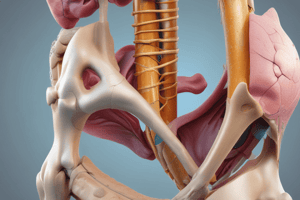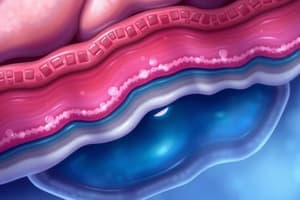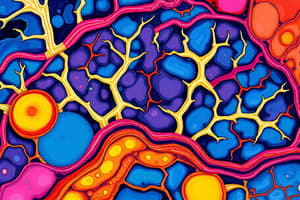Podcast
Questions and Answers
Which of the following is a characteristic of Osteoarthrosis/Osteoarthritis?
Which of the following is a characteristic of Osteoarthrosis/Osteoarthritis?
- More prevalent in younger individuals
- Caused by an influx of inflammatory cells into the synovial membrane
- Present in 40% of individuals >50 years old (correct)
- Results from chronic inflammation in the synovial membrane
What is the primary feature of the synovium in rheumatoid arthritis?
What is the primary feature of the synovium in rheumatoid arthritis?
- Formation of pannus (correct)
- Angiogenesis
- Proliferation of chronic inflammatory cells
- Degeneration of articular cartilage
Which of the following is NOT a feature of rheumatoid arthritis?
Which of the following is NOT a feature of rheumatoid arthritis?
- Proliferation of chronic inflammatory cells
- Degeneration of articular cartilage (correct)
- Influx of inflammatory cells into the synovial membrane
- Angiogenesis
What is the approximate percentage of individuals over 50 years old who have Osteoarthrosis/Osteoarthritis?
What is the approximate percentage of individuals over 50 years old who have Osteoarthrosis/Osteoarthritis?
Which of the following is a complication of rheumatoid arthritis?
Which of the following is a complication of rheumatoid arthritis?
What is the characteristic of Osteoarthrosis/Osteoarthritis in younger individuals?
What is the characteristic of Osteoarthrosis/Osteoarthritis in younger individuals?
What is a characteristic of Rheumatoid Arthritis?
What is a characteristic of Rheumatoid Arthritis?
What is a characteristic of Osteoarthritis?
What is a characteristic of Osteoarthritis?
Which type of gout is caused by internal or external factors?
Which type of gout is caused by internal or external factors?
What is a common feature of Rheumatoid Arthritis?
What is a common feature of Rheumatoid Arthritis?
What is the main cause of Gout?
What is the main cause of Gout?
Which type of gout is hereditary?
Which type of gout is hereditary?
What is a characteristic of Osteoarthritis?
What is a characteristic of Osteoarthritis?
What is a feature of Rheumatoid Arthritis?
What is a feature of Rheumatoid Arthritis?
What is the primary cause of hyperuricemia?
What is the primary cause of hyperuricemia?
What is the main characteristic of the crystals found in joint spaces in gouty arthritis?
What is the main characteristic of the crystals found in joint spaces in gouty arthritis?
Which of the following is NOT a laboratory finding in gouty arthritis?
Which of the following is NOT a laboratory finding in gouty arthritis?
What is the name of the characteristic deposits found in the ears and joints in chronic tophaceous arthritis?
What is the name of the characteristic deposits found in the ears and joints in chronic tophaceous arthritis?
What is the primary location of the first episode of acute gouty arthritis in 85% of cases?
What is the primary location of the first episode of acute gouty arthritis in 85% of cases?
What is the name of the chronic condition characterized by large deposits of urate crystals?
What is the name of the chronic condition characterized by large deposits of urate crystals?
What is the primary radiological finding in gouty arthritis?
What is the primary radiological finding in gouty arthritis?
What is the primary histological finding in synovial fluid analysis in gouty arthritis?
What is the primary histological finding in synovial fluid analysis in gouty arthritis?
What is the primary cause of chronic granulomatous inflammation in gouty arthritis?
What is the primary cause of chronic granulomatous inflammation in gouty arthritis?
What is the primary laboratory finding in acute gouty arthritis?
What is the primary laboratory finding in acute gouty arthritis?
What is the characteristic of rheumatoid arthritis that distinguishes it from other types of arthritis?
What is the characteristic of rheumatoid arthritis that distinguishes it from other types of arthritis?
What is the main component of the immune complex formed in the synovial fluid of rheumatoid arthritis patients?
What is the main component of the immune complex formed in the synovial fluid of rheumatoid arthritis patients?
What is the main cell type involved in the pathogenesis of rheumatoid arthritis?
What is the main cell type involved in the pathogenesis of rheumatoid arthritis?
What is the most common age group affected by rheumatoid arthritis?
What is the most common age group affected by rheumatoid arthritis?
What is the main reason for the presence of crepitus in joint disease?
What is the main reason for the presence of crepitus in joint disease?
What is the main difference between osteoarthritis and rheumatoid arthritis?
What is the main difference between osteoarthritis and rheumatoid arthritis?
What is the main laboratory finding in patients with rheumatoid arthritis?
What is the main laboratory finding in patients with rheumatoid arthritis?
What is the main radiological finding in patients with rheumatoid arthritis?
What is the main radiological finding in patients with rheumatoid arthritis?
What is the main complication of rheumatoid arthritis?
What is the main complication of rheumatoid arthritis?
What is the main feature of synovitis in rheumatoid arthritis?
What is the main feature of synovitis in rheumatoid arthritis?
What is the characteristic shape of urate crystals in gout?
What is the characteristic shape of urate crystals in gout?
What is the effect of formalin processing on urate crystals?
What is the effect of formalin processing on urate crystals?
What is the advantage of using alcohol fixation when examining urate crystals?
What is the advantage of using alcohol fixation when examining urate crystals?
What is the characteristic of monosodium urate crystals under polarized light microscopy?
What is the characteristic of monosodium urate crystals under polarized light microscopy?
What can be seen in a Giemsa-stained smear of a patient with gout?
What can be seen in a Giemsa-stained smear of a patient with gout?
What is the characteristic of calcium pyrophosphate dihydrate crystals viewed under polarized light microscopy?
What is the characteristic of calcium pyrophosphate dihydrate crystals viewed under polarized light microscopy?
Why are urate crystals difficult to visualize with routine staining?
Why are urate crystals difficult to visualize with routine staining?
What is the significance of negatively birefringent crystals in a patient's synovial fluid?
What is the significance of negatively birefringent crystals in a patient's synovial fluid?
Flashcards are hidden until you start studying
Study Notes
Inflammatory Response and Joint Diseases
- Influx of inflammatory cells into the synovial membrane
- Angiogenesis and proliferation of chronic inflammatory (mononuclear) cells and resident synovial cells
Rheumatoid Arthritis (RA)
- Chronic immunological disease with a progressive nature
- Potentially deforming arthritis with rheumatoid factor (autoantibody) present in most patients
- Formation of immune complex (rheumatoid factor + IgG) in synovial fluid
- Unknown cause, but suggested to have genetic predisposition and environmental factors
- 3:1 ratio of female to male, highest age incidence between 30-50 years
- 1-3% population worldwide affected
Pathogenesis of RA
- Triggering factor → autoimmune activation
- Autoantibodies (rheumatoid factors) attack synovial membrane
- Vasodilation and hyperplasia of synovial cells, leading to swelling and congestion
- Thickening of synovial membrane, erosion of articular cartilage, and subchondral bone
- Pannus formation, fibrosis, and deformity
Clinical Features of RA
- Symmetric involvement of small joints (hands and feet)
- Severe form: joint deformities, atrophy of muscles around the joint
Investigation and Findings of RA
- Laboratory: +ve for rheumatoid factor (80% patients), elevated ESR and CRP
- Radiology: X-ray shows deformed ulnar deviation of digits
- Ultrasound and MRI: not routine for patients with obvious clinical signs
Osteoarthritis (OA)
- Common degenerative disease of joints in the elderly
- Abnormalities in articular cartilage, present in 40% of individuals >50 years old
- Caused by joint abnormality in younger individuals
- Clinical manifestation: joint pain, swelling, crepitus, and abnormal joint mobility
Gout (Gouty Arthritis)
- A type of arthritis and metabolic disorder caused by elevated levels of uric acid in blood (hyperuricemia)
- Deposition of urate crystals in connective tissues
- Etiology: idiopathic, male > female (>30 years old), 2 types: primary (hereditary) and secondary (internal/external factors)
Pathology of Gout
- Hyperuricemia (>6.8 mg/dL) leads to formation of needle-shaped monosodium urate (MSU) crystals
- Asymptomatic with deposits in joints/tendons and surrounding tissues
- Acute gouty arthritis: inflammatory response mediated by MSU crystals
- Chronic granulomatous inflammation, erosion of articular cartilage, and deformity
Clinical Features of Gout
- Acute gouty arthritis: 85% of cases in metatarsophalangeal (big toe) joint
- Recurrent episodes, large deposits of chalky white urate (tophi) crystals
- Chronic tophaceous arthritis: erosion of articular cartilage, marked deformity
Investigation and Findings of Gout
- Laboratory: high uric acid levels, elevated ESR, and WBC = inflammation
- Radiology: X-ray and CT show bony erosions or tophi
- Histology: synovial fluid analysis → needle-shaped negatively birefringent urate crystals
Studying That Suits You
Use AI to generate personalized quizzes and flashcards to suit your learning preferences.




